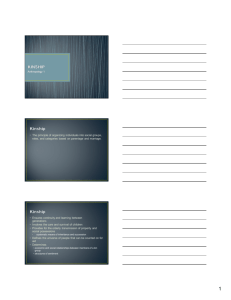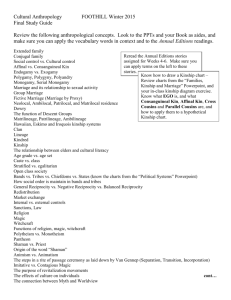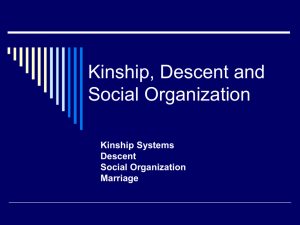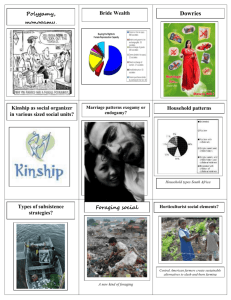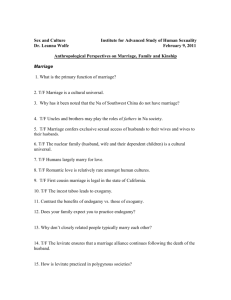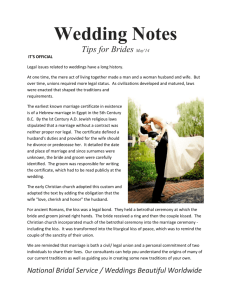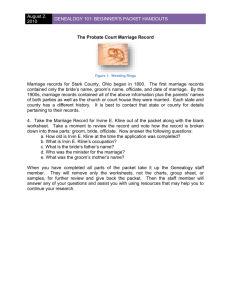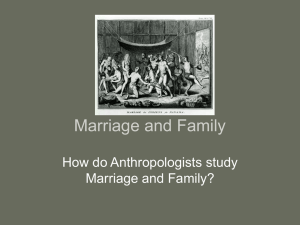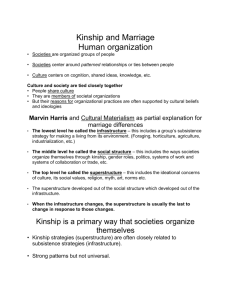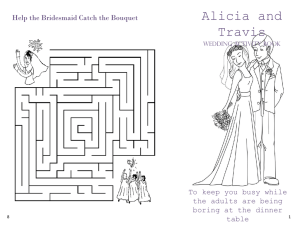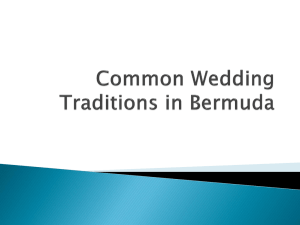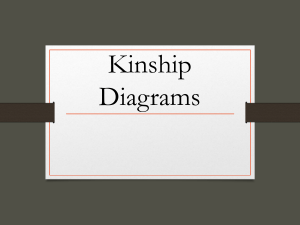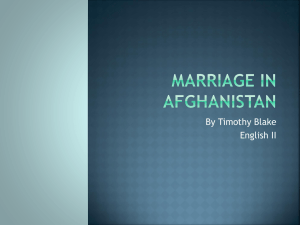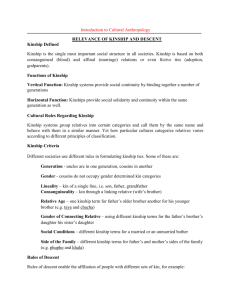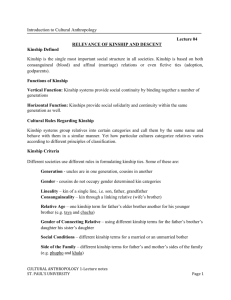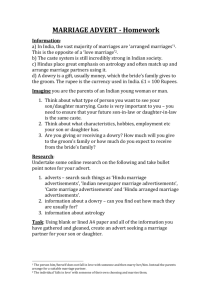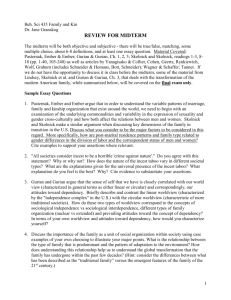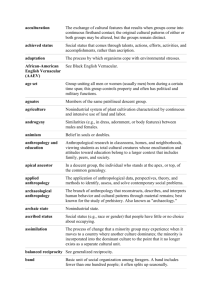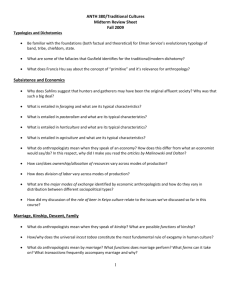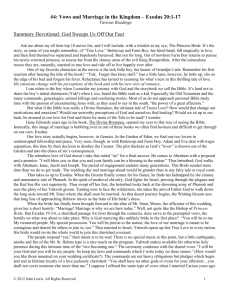AnthroKinship
advertisement
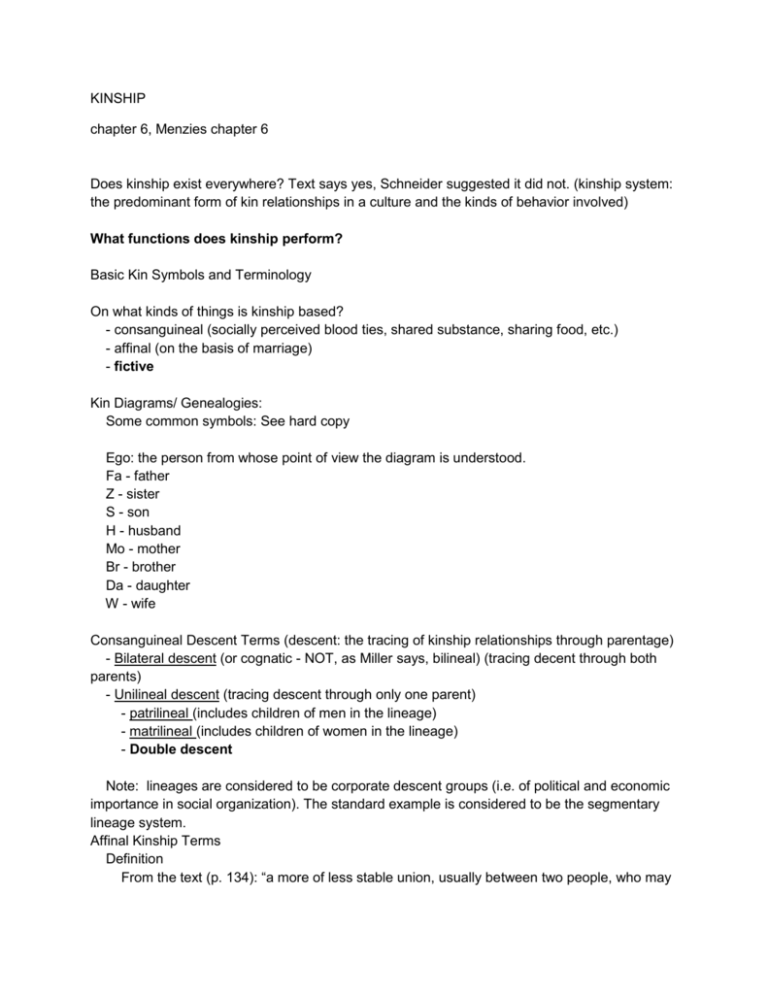
KINSHIP chapter 6, Menzies chapter 6 Does kinship exist everywhere? Text says yes, Schneider suggested it did not. (kinship system: the predominant form of kin relationships in a culture and the kinds of behavior involved) What functions does kinship perform? Basic Kin Symbols and Terminology On what kinds of things is kinship based? - consanguineal (socially perceived blood ties, shared substance, sharing food, etc.) - affinal (on the basis of marriage) - fictive Kin Diagrams/ Genealogies: Some common symbols: See hard copy Ego: the person from whose point of view the diagram is understood. Fa - father Z - sister S - son H - husband Mo - mother Br - brother Da - daughter W - wife Consanguineal Descent Terms (descent: the tracing of kinship relationships through parentage) - Bilateral descent (or cognatic - NOT, as Miller says, bilineal) (tracing decent through both parents) - Unilineal descent (tracing descent through only one parent) - patrilineal (includes children of men in the lineage) - matrilineal (includes children of women in the lineage) - Double descent Note: lineages are considered to be corporate descent groups (i.e. of political and economic importance in social organization). The standard example is considered to be the segmentary lineage system. Affinal Kinship Terms Definition From the text (p. 134): “a more of less stable union, usually between two people, who may be, but are not necessarily, co-residential, sexually involved with each other, and procreative with each other.” Contrast with this one, not from the text: “Marriage is a socially binding contract that usually involves some definition of sexual relationship, access to property, mutual obligations for the provision of income or services, and outlines obligations and rights to children.” Monogamy - one spouse Serial monogamy: one spouse at a time, but several through one’s life Polygamy - multiple spouses: - polygyny (one man, several wives) - polyandry (one woman, several husbands [usually brothers]) - group marriage Preferences: e.g. for cross cousins(offspring or either one’s father’s sister or one’s mother’s brother) or parallel cousins (offspring of either one’s father’s brother or one’s mother’s sister); members of specific groups or with specific personal characteristics -notion of romantic love versus arranged marriages Exogamy: rule that prescribes marriage outside a specific group -NOTE: NEEDS AN ADJECTIVE Endogamy: rule that prescribes marriage within a specific group -NOTE: NEEDS AN ADJECTIVE Incest taboo: rule that prohibits marriage within a specific subset of kin (a strongly help predisposition against marrying or having sex with a particular kin) Hypergamy: Bride marries up Hypogamy: Bride marries down Isogamy: Bride and groom of equivalent status Marital exchanges: - bridewealth (NOT usually called bride price any more): goods that go from the groom’s family to the married couple - brideservice: work performed by the groom for the wife’s family - dowry: goods given by the wife’s family to the groom, or the groom’s family, or held in trust for the children - groom price: goods that go from bride’s family to married couple and groom’s family - wedding presents: goods given by family and friends to the bride and groom Fictive Kinship Examples include godparenthood, use of kin terms in unions, use of kin terms for close family friends, etc. Household: a domestic group that may or may not be related by kinship and that shares living space, including perhaps a kitchen and certain budgetary items such as food and rent. What are the structural forms that households can take in different societies? - based on descent system and marriage rules - family based households may be nuclear household (a domestic group that contains one adult couple with or without children) or extended household (domestic group that contains more than one adult married couple) in form, depending on descent system, wider political and economic patterns, including mobility - who “heads” a household and why? - how does divorce or death affect household structure? What are intra-household relations like in different societies? - what are relations like between different kin, such as between husband and wife, siblings, wife and husband’s mother, parents and children? - what might be the causes of domestic violence? Males dominating as perpetrators and women as victims, wife beating is more common and more severe in contexts where men control the wealth. What roles might households fulfill in different societies? - domestic work - produce children (who might migrate and send remittances back) - farm - business How do households change due to divorce, remarriage, migration, economic change, health epidemics, demographic change, etc.? Menzies: - shows how kinship patterns, especially the property and occupations of parents, influence marriage patterns, occupations of children - also notes the importance of factors deriving from the French state, such as opportunities and restrictions related to education, pensions, job opportunities apart from fishing and farming in other areas of France after 1950s, etc. Marriage: a union, usually between two people who are likely to be, but are not necessarily, coresident, sexually involved with each other, and procreative Family: a group of people who consider themselves related through a form on kinship, such as descent, marriage, or sharing
